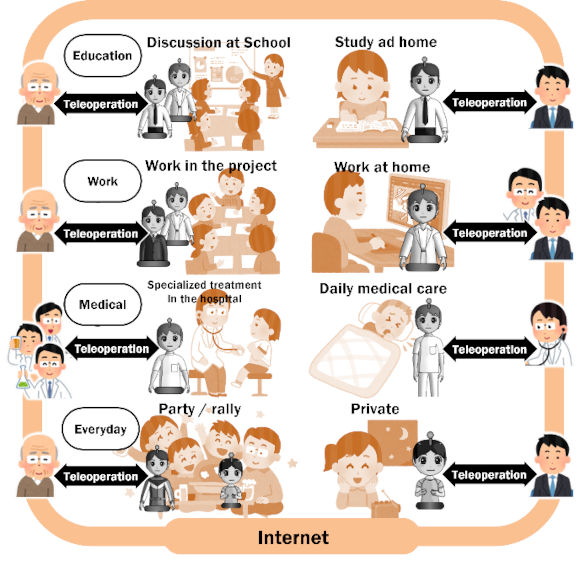R&D Project

Goal 1 R&D Projects (Selected in 2020)The Realization of an Avatar-Symbiotic Society where Everyone Can Perform Active Roles without Constraint
Project manager (PM)ISHIGURO HiroshiProfessor, Graduate School of Engineering Science, The University of Osaka
Summary of the project
By developing cybernetic avatars (CAs) with the essential function of hospitality-rich and moral dialogue, this project will realize an avatar-symbiotic society where even people constrained by time and space can participate in various social activities through remote operation of CAs. In this new society, diverse human resources can quickly solve problems by utilizing CA through remote operation even when social-scale problems occur. Thus, the society will successfully transform into a large scale remote mutual aid society. Moreover, the intervention of CA will lead to a secure daily life for the people who live alone as different professionals watch them over.
After CA technology enhances operators' physical and cognitive abilities and strengthens their vitality, our goal by 2030 is for multiple operators to engage in educational, medical, and other tasks by teleoperating with several CAs. By 2050, everyone, not only specialists, will be able to expand their ability to work more actively regardless of time and space via CA. The dramatic lifestyle change will bring us to realize an avatar-symbiotic society well-balanced between CA technology and community.

Milestone by year 2030
[Realization of a large-scale and remote mutual aid society]
In times of disasters/pandemics, each specialist juxtaposes CAs and coordinates CAs for dialogue and action. Then we can efficiently get a picture of damage or epidemic situations from hard-to-reach places.
[Allowing a secure daily life watched over by different professionals]
Owing to professionals of law, medical/nursing care, and education operating CAs (for half-automation) and coordinating with other CAs, the elderly or challenged will be able to receive necessary services (care, consultation, motion assistance, learning support) anywhere, at any time.
Milestone by year 2025
[Enabling people in various situations to participate in social activities]
In an open place (e.g., facilities, or Expo), housewives, househusbands, the elderly, and the challenged can involve in amiable conversation and activity under CA’s control which can interact with other CAs, and understand users’ needs that vary with age, gender, nationality, and disabilities.
R&D theme progress reports
- 1. Development of a CA which has a humanlike presence and a lifelikeness
- 2. Research and development on unconstrained spoken dialogue
- 3. Human level knowledge and concept acquisition
- 4. Cooperative control of multiple CAs
- 5. Development of CA platform
- 6. Multidisciplinary investigation on how avatars and devices affect users
- 7. Field experiments in the real world
- 8. Avatar Social Ethics Design
- Progress Report (1.37MB)
Performers
| Theme [1] | ISHIGURO Hiroshi | The University of Osaka |
|---|---|---|
| Theme [1] | OGAWA Kohei | Nagoya University |
| Theme [1] | NAKATA Yoshihiro | The University of Electro-Communications |
| Theme [1] | SHIOMI Masahiro | Advanced Telecommunications Research Institute International |
| Theme [1] | YOSHIKAWA Yuichiro | The University of Osaka |
| Theme [1] | MINATO Takashi | RIKEN |
| Theme [1] | NAKAMURA Yutaka | RIKEN |
| Theme [2] | KAWAHARA Tatsuya | Kyoto University |
| Theme [2] | SARUWATARI Hiroshi | The University of Tokyo |
| Theme [2] | HIGASHINAKA Ryuichiro | Nagoya University |
| Theme [2] | LEE Akinobu | Nagoya Institute of Technology |
| Theme [2] | KOMATANI Kazunori | The University of Osaka |
| Theme [3] | HARADA Tatsuya | The University of Tokyo |
| Theme [3] | KUROSE Yusuke | The University of Tokyo |
| Theme [3] | Lin Gu | RIKEN |
| Theme [3] | MUKUTA Yusuke | The University of Tokyo |
| Theme [3] | SUZUKI Jun | Tohoku University |
| Theme [4] | HORII Takato | The University of Osaka |
| Theme [4] | NAKAMURA Tomoaki | The University of Electro-Communications |
| Theme [4] | SUGIURA Komei | Keio University |
| Theme [4] | TANIGUCHI Tadahiro | Ritsumeikan University / Kyoto University |
| Theme [4] | SUZUKI Yosuke | Kanazawa University |
| Theme [4] | HIRATA Masayuki | The University of Osaka |
| Theme [5][7] | MIYASHITA Takahiro | Advanced Telecommunications Research Institute International |
| Theme [5] | UTSUMI Akira | Advanced Telecommunications Research Institute International |
| Theme [5] | YOSHIMI Takashi | Shibaura Institute of Technology |
| Theme [6] | KAWAOKA Shinpei | Kyoto University / Tohoku University |
| Theme [6] | IZUMI Yoshihiro | Kyushu University |
| Theme [6] | HARUNO Masahiko | National Institute of Information and Communications Technology |
| Theme [6] | SUMIOKA Hidenobu | Advanced Telecommunications Research Institute International |
| Theme [6] | NAKAE Aya | Advanced Telecommunications Research Institute International |
| Theme [7] | KUMAZAKI Hirokazu | Nagasaki University |
| Theme [7] | NISHIO Shuichi | The University of Osaka |
| Theme [7] | ARAKAWA Shinichi | The University of Osaka |
| Theme [7] | SODEYAMA Yoshinao | Sony Group Corporation |
| Theme [8] | NAKANO Yukiko | Seikei University |
| Theme [8] | KANDA Takayuki | Kyoto University |
| Theme [8] | KUKITA Minao | Nagoya University |
| Theme [8] | YUASA Harumichi | Meiji University |
| Theme [8] | Alberto Sanfeliu | Universitat Politècnica de Catalunya Institut de Robòtica i Informàtica Industrial |
PDF Download
- Summary of the project (288KB)
 Project Site
Project Site